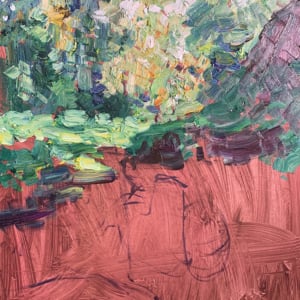I have some catching up to do with the On the Easel posts. I painted Airlie Beach in August and have done a few since then.
I traveled to Airlie Beach recently with my brother and father. It’s a stunning place in the Whitsundays, within reach despite the world’s travel restrictions. We were blessed with perfect weather; glassy turquoise water, pure white sand, and not a cloud in the sky. It would have been ideal to paint alone from the beach itself, but it wasn’t one of those trips. Photos and memory had to do for this painting. This was also the first time I painted on Ampersand gessoboard. Now my painting surface of choice.
Anyway, here’s the finished painting, along with notes and progress shots.

(Before diving into this post, make sure to pick up a copy of my free Landscape Painting Starter Kit.)
Reference Photo
Cameras have limitations. They cannot capture color as we see it. They do a fantastic job, but a photo is no substitute for our own perception. This is particularly evident in high-contrast scenes like below. The shadows are underexposed and the colors are lost in darkness. The camera also picked up glare in the top left-hand corner. I needed to take all this into account when painting from this photo.

Details
- Oil on Ampersand Gessoboard. 12 x 16 inches.
- Main colors: Ultramarine blue, cobalt blue, alizarin crimson, cadmium red, cadmium yellow deep, cadmium yellow, viridian green, titanium white.
Refer to my supplies list for more details on what I use.
Notes
- I painted from the reference photo, my memory of the scene, and the following color study (5 x 7 inches). It seems I rarely confront a large studio painting without having at least one small study under my belt.

- I used a segmented approach, painting one segment to near completion, then onto the next. The trouble with this approach is the end result may look disjointed, like an assortment of well-painted parts rather than a coherent finished painting. But I feel that’s not the case here.
- I painted directly onto the white gessoboard surface, rather than applying a thin stain of color, as I often do. I have no real reason for doing this, other than it felt like the right approach at the time.
- I departed from the reference photo for the shadows, relying more on my memory of the scene. As I mentioned earlier, cameras are not good at capturing color in shadows.
- I took advantage of a wide variety of techniques. For the dappled light, I wiped away paint with a solvent-dabbed paper towel. For the high-key colors, I used a palette knife to apply impasto strokes of color. For the dark trees in the top left-hand corner, I applied thin washes of color then lifted paint with a paper towel and a loose hand.
- I used small bursts of color to depict activity on the beach, focused on capturing the impression rather than form. I drew inspiration from the Russian impressionists for this.
Progress Shots








Additional Resources
Thanks for Reading!
Thanks for taking the time to read this post. I appreciate it! Feel free to share with friends. If you want more painting tips, check out my Painting Academy course.
Happy painting!
Dan Scott
Draw Paint Academy







Love your progress notes, and honest remarks. This is how we all learn.
I do this myself and post my work on Facebook (Sylvia Hayes).
Hi Dan, hello and welcome, I really want to draw this drawing of yours, can I?
Hi Dan, hello and welcome, I really want to draw this drawing of yours, can I?
Hi Shlomo. Do you want to draw the reference photo do you mean? That is fine, no worries at all!